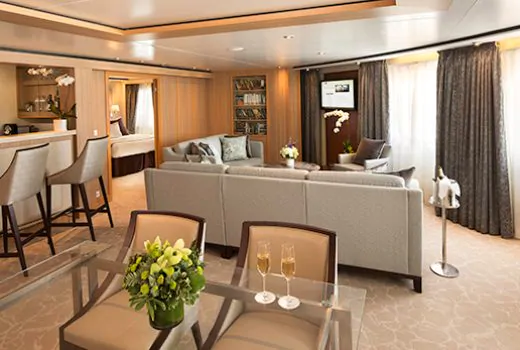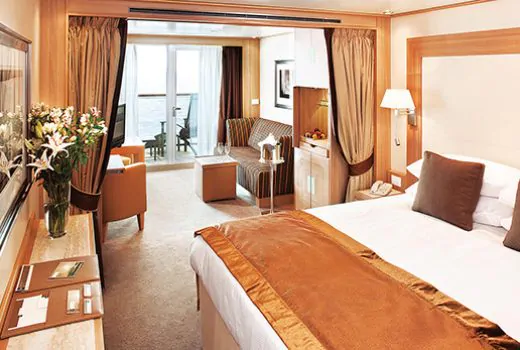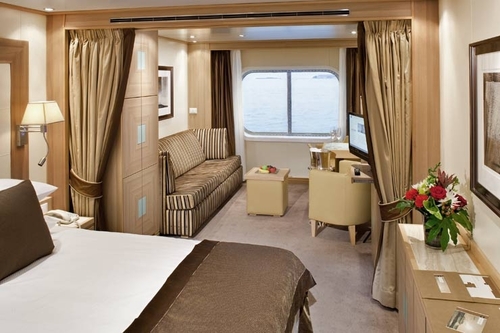Mediterranean Jewels & Atlantic Crossing
- 25 Nov ‘26
- 24 nights
- Departing from Barcelona
- Seabourn Sojourn
-
Inside price fromCall for price
-
Outside price from$14,499*/pp
-
Balcony price from$16,699*/pp
-
Suite price from$27,699*/pp
YOUR ITINERARY
Barcelona, Spain - Valencia, Spain - Cartagena, Spain - Malaga, Spain - Gibraltar, British Territory - Tangier, Morocco - Cadiz (Seville), Spain - Leixoes (Porto), Portugal - Leixoes (Porto), Portugal - Lisbon, Portugal - Funchal (Madeira), Portugal - Porto Santo (Madeira) - Miami, Florida
Barcelona, the capital of Catalonia, is said to have been fou...
Barcelona, the capital of Catalonia, is said to have been founded by the Phoenicians, and was once the rival of the powerful states of Venice and Genoa for control of the Mediterranean trade. Today, it is Spain’s second largest city and has long rivaled, even surpassed Madrid in industry and commerce. The medieval atmosphere of the Gothic Quarter and the elegant boulevards combine to make the city one of Europe’s most beautiful. Barcelona’s active cultural life and heritage brought forth such greats as the architect Antonio Gaudi, the painter Joan Miro, and Pablo Picasso, who spent his formative years here. Other famous native Catalan artists include cellist Pau Casals, surrealist Salvador Dali, and opera singers Montserrat Caballe and Josep Carreras. Barcelona accomplished a long-cherished goal with the opportunity to host the Olympics in 1992. This big event prompted a massive building program and created a focal point of the world’s attention.
Valencia is located in the middle of Europe’...
Valencia is located in the middle of Europe’s most densely developed agricultural region. Originally a Greek settlement, the town was taken over by Romans in 138 BC and turned into a retirement town for old soldiers. The Moors controlled the land for 500 years, and this fertile plain, which today yields three to four crops, was considered to be heaven on earth. El Cid conquered Valencia for Spain in 1094, but it fell back into Moorish hands after his death. Incorporated into Spain in the 15th century, Valencia remains the nation’s breadbasket.
Founded by Carthaginians in the third century BC, this an...
Founded by Carthaginians in the third century BC, this ancient Mediterranean port city exemplifies the region’s tumultuous history. Romans, Visigoths, Castilians and Moors have all left their marks. Under King Philip II, Cartagena’s naturally deep, sheltered harbor was developed into the nation’s premier naval base, a position it still enjoys today. Ancient ramparts remain, as does a lighthouse erected in Moorish times.
Often little more than a gateway to the Costa del S...
Often little more than a gateway to the Costa del Sol for sun-seeking vacationers, Malaga is a most interesting city in its own right. First settled by the Phoenicians, Malaga was held by virtually every ruling power in the Mediterranean at one time or another. Two Moorish fortresses, the 11th-century Alcazaba and the 14th-century Castillo de Gibralfaro still stand sentry above the harbor. Malaga was the birthplace of Pablo Picasso as well as the Malaguena style of flamenco. During your time here, you may wish to sample some of the sweet Malaga wine and excellent tapas for which the city is noted.
With Spain to the north and Morocco to the south, Gibra...
With Spain to the north and Morocco to the south, Gibraltar is the famous promontory dominating the narrow entrance to the Mediterranean. Its position led to its seizure by the Moors in 711 as a prelude to the conquest of Spain. The Moorish influence includes the name Gibraltar, a corruption of “Jebel Tariq” (Tariq’s Mountain), named after the Moorish commander Tariq who built the first fortification. In ancient times Gibraltar was regarded as one of the two Pillars of Hercules, which marked the western limits of the known world. Known commonly as “The Rock,” Gibraltar is full of natural caves and manmade tunnels. The Rock itself, composed of limestone and gray marble, is geographically part of the Iberian Peninsula. Politically, the British have controlled Gibraltar for over two centuries. This tiny self-governing British Colony welcomes you to enjoy its historical sites, magnificent views, beautiful beaches and duty free shops.
Situated just across the narrow Strait of Gibraltar from Eur...
Situated just across the narrow Strait of Gibraltar from Europe, Tangier has long comprised a hybrid culture that is nearly as European as it is African. Standing atop Cap Spartel, one can gaze down on the place where the Atlantic meets the Mediterranean. The “Hollywood” district where the foreign embassies have traditionally been located reflects the European influence. But ascending the hill above the waterfront, one enters the narrow, winding alleys of the Kasbah, the city’s oldest, most Moroccan section. Down the coast, nearby Tetouan retains a nearly untouched walled medina, with sections originally occupied by Andalusian, Berber and Jewish populations. It is small enough that visitors can explore it without risking becoming lost, making it a perfect choice as a UNESCO World Heritage Site.
To taste the true flavor of this ancient port city, one shoul...
To taste the true flavor of this ancient port city, one should stroll its seaside promenade, pausing to rest beneath the huge banyan trees. The narrow, winding streets of the old town fan out from the port, leading you to sunny, palm-lined plazas. Visit the Catedral Nueva (New Cathedral), begun in the early 1800s but not completed for 116 years. Its dramatic, golden dome rises over a striking interior. For those who enjoy people-watching as much as sightseeing, the seafood restaurants along the eastern edge of the port provide the ideal setting.
The commercial center of northern Portugal and hu...
The commercial center of northern Portugal and hub of the port wine trade, Porto is a gracious, cosmopolitan city noted for its 12th century cathedral and medieval churches, picturesque narrow streets and wine lodges at Vila Nova de Gaia. It is clustered on hills overlooking a river, and is a northern European style city with granite church towers, narrow streets and hidden Baroque treasures.
The commercial center of northern Portugal and hub o...
The commercial center of northern Portugal and hub of the port wine trade, Porto is a gracious, cosmopolitan city noted for its 12th century cathedral and medieval churches, picturesque narrow streets and wine lodges at Vila Nova de Gaia. It is clustered on hills overlooking a river, and is a northern European style city with granite church towers, narrow streets and hidden Baroque treasures.
The great period of “the Discoveries” acco...
The great period of “the Discoveries” accounted for phenomenal wealth brought back from India, Africa and Brazil by the great Portuguese navigators. Gold, jewels, ivory, porcelain and spices helped finance grand new buildings and impressive monuments in Lisbon, the country’s capital city. As you sail up the Tagus River, be on deck to admire Lisbon’s panorama and see some of the great monuments lining the river. Lisbon is one of Europe’s smallest capital cities but considered by many visitors to be one of the most likeable. Spread over a string of seven hills, the city offers a variety of faces, including a refreshing no-frills simplicity reflected in the people as they go unhurriedly through their day enjoying a hearty and delicious cuisine accompanied by the country’s excellent wines.
The Madeira Archipelago, consisting of the islands Madeira...
The Madeira Archipelago, consisting of the islands Madeira, Porto Santo and Desertas, is situated in the Atlantic, about 400 miles from the African coast and 560 miles from Lisbon. Discovered by the Portuguese in 1419, Madeira, the largest of the islands, became of great importance to Portugal for its sugar production and later on for the cultivation of wine. The unusually temperate oceanic climate and extraordinary scenery had Northern Europeans flocking to Madeira as early as the 18th century to spend the winter months. The winning combination of high, rocky peaks, steep green ravines and waterfalls in the interior, with the flowering charm of Funchal still attracts nearly half a million visitors each year.
The Madeira Archipelago, consisting of the islands Madeira, Port...
The Madeira Archipelago, consisting of the islands Madeira, Porto Santo and Desertas, is situated in the Atlantic, about 400 miles from the African coast and 560 miles from Lisbon. Discovered by the Portuguese in 1419, Madeira, the largest of the islands, became of great importance to Portugal for its sugar production and later on for the cultivation of wine. The unusually temperate oceanic climate and extraordinary scenery had Northern Europeans flocking to Madeira as early as the 18th century to spend the winter months. The winning combination of high, rocky peaks, steep green ravines and waterfalls in the interior, with the flowering charm of Funchal still attracts nearly half a million visitors each year.
Miami is the busiest cruise port in the world, hosting ...
Miami is the busiest cruise port in the world, hosting a myriad of ships year-round from all over the globe. Although it is technically not on the Caribbean Sea, no other American city exudes more of the diverse tropical appeal of the Caribbean. The city is home to a large and vibrant immigrant population that blends snowbird refugees from more northern climes with emigres from all Latin America and the Caribbean, as well as sizable groups from Europe, the Middle East and Asia. From the hot-blooded Art Deco haunts of South Beach to the natural wonders of the UNESCO-inscribed Everglades and the laid-back charms of the Keys, South Florida offers a bounty of appealing attractions that make an extended stay in the region nearly mandatory for those either embarking or disembarking here.
YOUR SHIP - The Seabourn Sojourn
Seabourn Sojourn enchants her guests with an array of public areas scaled to encourage a relaxed sociability. One of the most unusual features of Seabourn Sojourn and her sisters is Seabourn Square, an ingenious “living room” that replaces the traditional cruise ship lobby with a welcoming lounge filled with easy chairs, sofas and cocktail tables; making it more inviting and relaxing on a small ship cruise. An enclave in its center houses knowledgeable concierges discreetly seated at individual desks.
Seabourn Sojourn enchants her guests with an array of public areas scaled to encourage a relaxed sociability. One of the most unusual features of Seabourn Sojourn and her sisters is Seabourn Square, an ingenious “living room” that replaces the traditional cruise ship lobby with a welcoming lounge filled with easy chairs, sofas and cocktail tables; making it more inviting and relaxing on a small ship cruise. An enclave in its center houses knowledgeable concierges discreetly seated at individual desks.
Beauty Salon
Facial Treatments
Massage
Sauna
Spa
Swimming Pool
Thalassotherapy Pool
Whirlpool
In-Suite Service
Patio Grill
Sky Bar
The Colonnade
The Restaurant
The Restaurant 2
Gym
Sports Deck
Description
Seabourn Sojourn enchants her guests with an array of public areas scaled to encourage a relaxed sociability. One of the most unusual features of Seabourn Sojourn and her sisters is Seabourn Square, an ingenious “living room” that replaces the traditional cruise ship lobby with a welcoming lounge filled with easy chairs, sofas and cocktail tables; making it more inviting and relaxing on a small ship cruise. An enclave in its center houses knowledgeable concierges discreetly seated at individual desks.
Relaxation
Beauty Salon
Facial Treatments
Massage
Sauna
Spa
Swimming Pool
Thalassotherapy Pool
Whirlpool
Food and Drink
In-Suite Service
Patio Grill
Sky Bar
The Colonnade
The Restaurant
The Restaurant 2
Fitness
Gym
Sports Deck
STATEROOMS

suite

balcony


